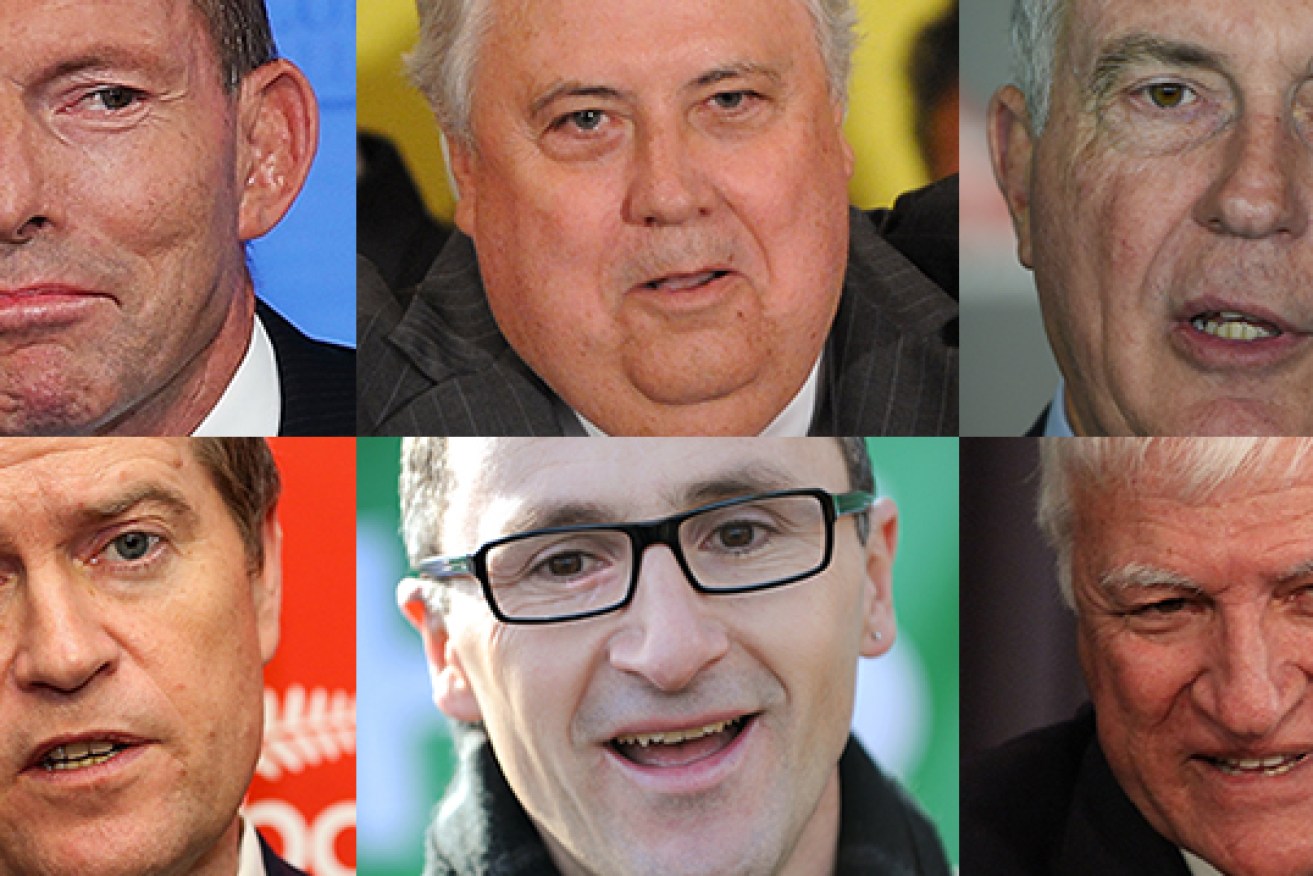Australian politics: where have all the women gone?

While debate rages in the US about how a reporter characterised a stoush between presidential candidates Hillary Clinton and Carly Fiorina as a “weird girl fight”, Australia has discovered a novel way to deal with the gender issue – by not having any federal female political leaders to be sexist about in the first place.
With Richard Di Natale taking over from Christine Milne as party leader of the Greens, Australia’s major political forces are once again fronted exclusively by middle-aged white men.
• Was Christine Milne pushed or did she jump?
• New mums shouldn’t be fair game
• ‘Oversharenting’ must stop: Angela Pippos
 Prime Minister Tony Abbott leading the Coalition government, Bill Shorten fronting the Labor opposition, Deputy Prime Minister Warren Truss in charge of the Nationals, and Clive Palmer in charge of Clive Palmer – our political leading lights are as white and blokey as ever.
Prime Minister Tony Abbott leading the Coalition government, Bill Shorten fronting the Labor opposition, Deputy Prime Minister Warren Truss in charge of the Nationals, and Clive Palmer in charge of Clive Palmer – our political leading lights are as white and blokey as ever.
It is not just in leadership positions that Australia’s political class is demographically challenged – the Senate and House of Representatives remain distinctly unrepresentative as well.
Although women make up more than half of the Australian population, they hold roughly 29 per cent of State and Federal parliament positions.
And yet on this day in 2012, Australian women were at the forefront of the nation’s political and public life: Julia Gillard was our Prime Minister, Quentin Bryce our Governor-General, Nicola Roxon was serving as Australia’s first female Attorney-General, Lara Giddings was a year into her three-year term as Premier of Tasmania, Katy Gallagher was Chief Minister of the ACT and Christine Milne was the newly-elected leader of the Greens.
It wasn’t all plain sailing – six weeks earlier Anna Bligh had been dumped as Premier by the voters of Queensland after a distinguished four-and-a-half years in office – but women were very much in the ascendancy in Canberra and beyond.
Now, just three years later, they’re all gone, replaced by … blokes.
It wasn’t always this way
Professor Carmen Lawrence, Fellow at the University of Western Australia, knows a thing or two about challenging the status quo in politics, having served as Australia’s first ever female Premier and Treasurer of a state government.
After her stint as Labor Premier of WA from 1990 to 1993, Professor Lawrence moved on to Federal parliament before retiring from politics in 2007.
She told The New Daily that while a minority of “unreconstructed misogynist” voters are part of the reason a gender gap still exists in politics, the issue was more about gender being a distraction.
“I call it the ‘sore thumb’ effect – sometimes you stick out in ways that aren’t helpful to people assessing your policies rather than who you are,” she said.
Professor Lawrence pointed to the treatment of Julia Gillard during her period as PM as evidence that sexism is alive and well in politics.
“For a lot of women that was a salutatory lesson on the way women can be treated,” she said.
“I was no particular fan of Gillard’s policies, but the way she was treated by the media was undeniably sexist.”
Nevertheless, she argued that progress is being made, pointing to Annastacia Palaszczuk’s unlikely ascension to power in Queensland in February, a rise steeped in far less controversy than the Gillard prime ministership.

Australia’s first female Prime Minister was treated terribly by the media during her time in office, says Professor Carmen Lawrence. Photo: Australian Women’s Weekly
“If you look at Queensland now there is both a female premier and deputy, in an election win that was against the odds, and people knew they were voting for her,” she said.
Professor Lawrence backs her former party’s position on enforcing a minimum preselection quota of 40 per cent of female candidates as an essential ingredient in fostering political gender equality, despite criticism claiming the policy is toothless and favours gender over merit.
Rwanda is the country with the highest representation of women in politics – 63.8 per cent in the lower house, according to the Inter-Parliamentary Union.
The troubled central African nation has a mandatory quota for female representation, but others such as Finland (42.5 per cent) have are closing on gender parity without a quota.
Great Britain has gone to the polls to elect their next government. While some of the political parties there have a rudimentary quota system, the two leaders in contention for the Prime Ministership – Conservative leader David Cameron and Labour’s Ed Milliband – are white, middle aged and male. Surprised?
The more old-fashioned approach Great Britain applies to the most senior position of all seems to be the most effective, however. It might only be by default, but that country’s (and our) queen is a woman, after all.
Proportional representation?
While there is no data on the ethnic make-up of our politicians, the Parliamentary Handbook does reveal that 11.5 per cent of federal representatives were born overseas, falling well short of the general population’s 24.6 per cent overseas-born rate.
Two of the four largest source countries for immigrants, China and India, feature just one federal representative between them – Senator Dio Wang of the Palmer United Party.








